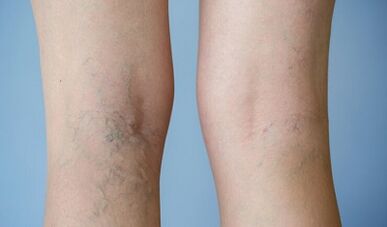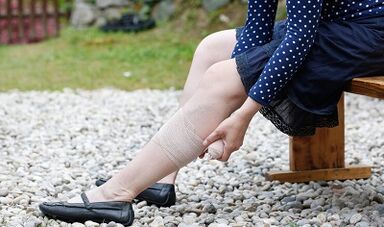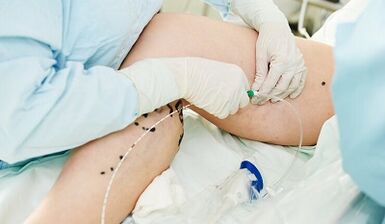
Signs of varicose veins in women are often found - this pathology is detected in almost every third woman.This disease, accompanied by the expansion of the lumen and thinning of the walls of the venous vessels, leads not only to the appearance of cosmetic defects, but also accompanied by pain and impaired nutrition of tissues of the lower extremities.As a result, in the absence of treatment, a woman may have trophic ulcers on her legs, which entail even more severe complications.That is why the beginning of the treatment of varicose veins should always be timely.
Signs of varicose veins in women are not always noticeable in the initial stages - sometimes the disease occurs hidden for a long time.
Causes and first signs
On the legs, the veins are affected by varicose veins under the influence of the following factors:
- Excess weight;
- heredity;
- sedentary lifestyle;
- long stay in a static position;
- pregnancy;
- childbirth;
- reception of high -type contraceptives;
- increasing pressure in the abdominal cavity with frequent or protracted cough, sneezing or constipation;
- overloads in physical training or loads;
- foot injuries;
- pelvic pathologies;
- abuse of tan or thermal procedures;
- wearing uncomfortable shoes;
- the habit of sitting a leg on the leg;
- alcohol abuse;
- elderly age.
Due to the increase in pressure in venous vessels and stagnation of blood, the vessels become stretched, blood flow in them change their direction and current speed, since the walls of the vessels change their tone, and the valves stop functioning normally.As a result, changes in the veins lead to the development of a closed circle in hemodynamics and other functions of the venous vessels.
In the initial stages of varicose veins, blood flow can still be compensated by conservative means - wearing compression linen, gymnastics and the use of venotonics.However, as the disease progresses, changes in the structure of veins become irreversible and can only be eliminated surgically.
Symptoms of varicose veins can significantly violate the usual rhythm of life.
The first signs of varicose veins can become the following manifestations:

- severity in the legs;
- the appearance of telangiectasias - vascular stars and nets of different colors (bluish, red, black);
- sensations of bursting during a long stay in a motionless position (sitting, standing);
- convulsions at night;
- Reducing the severity of symptoms after walking or rest in a horizontal position.
Often, the first manifestations of this common disease are written off to fatigue, and a visit to the doctor can be deposited until the severe consequences of the disease.As the expansion of the venous walls progress, the symptoms become more pronounced, and then new ones are added to the above manifestations.
Symptoms
Varicose expansion in later stages is manifested by the following features:
- Fast fatigue in the legs;
- pain;
- sensations of overflow with liquid;
- swelling of soft tissues after loads;
- Transity and protrusion over the skin of expanded large veins;
- skin itching;
- bruises due to rupture of large vessels;
- peeling of the skin;
- hair loss;
- Trophic ulcers.
Against the background of varicose veins in women in the lumen of veins, blood clots - blood clots.During their migration along the bloodstream, various consequences develop in their severity: thrombosis, fletrombosis, the development of cardiovascular diseases, the autopsy and suppuration of ulcers, the falling of bloodlines into the vessels of the heart or lungs.
Diagnostics and treatment
To confirm the diagnosis, a woman should consult a vascular surgeon and undergo an examination.The diagnostic plan includes examination with instrumental research:
- Ultrasound Dopplerography of the vessels of the legs;
- duplex angioscaning;
- reovasography;
- X -ray and radionuclide methods.
The tactics of the treatment of varicose veins are determined by the stage of the disease.At the early stage, conservative means can be used:
- wearing compression knitwear or bandaged bandages;
- sufficient motor activity;
- wearing comfortable shoes;
- physiotherapy physical education;
- elimination of static load on the legs;
- The use of venotonics.
The duration of conservative therapy is individual and depends on the rate of progression of the disease and compliance with the doctor's recommendations.It can be supplemented with a special diet, which implies the introduction of products into the diet that helps to strengthen the walls of blood vessels.
The probability that varicose veins will retreat under the onslaught of conservative methods of treatment is determined by each clinical case.In many ways, the success of therapy depends on the timeliness of seeing a doctor.
Also, these methods of therapy are recommended at the stage of preparation for surgical treatment or those patients who are contraindicated in invasive intervention.
Sometimes the prevention of varicose progression may consist in performing minimally invasive interventions.They are applicable only according to strict indications that are determined during the examination of the patient.
Treatment of varicose veins in advanced stages usually involves the implementation of a surgical operation - minimally invasive or classic.

If possible, a woman is recommended for radical treatment of varicose veins:
- compression sclerotherapy;
- laser coagulation;
- photocoagulation;
- Radio frequency coagulation.
If the effects of these minimally invasive methods are not enough, then classic operations are performed for more radical surgical treatment:
- Miniflebectomy;
- phlebectomy;
- Trendelenburg method (with complications of thrombosis and infection).
Sometimes classical surgical techniques are supplemented by the use of minimally invasive ones.Such a combination allows you to reduce the injury of operations and reduces the period of postoperative rehabilitation.
Varicose disease of the lower extremities can be successfully treated, especially in the early stages.That is why the first signs of this disease should always become the reason for visiting a vascular surgeon.Varicose veins can occur at different ages, and observations show that women often suffer from this ailment.Signs of varicose veins in women are the same as in men.
























